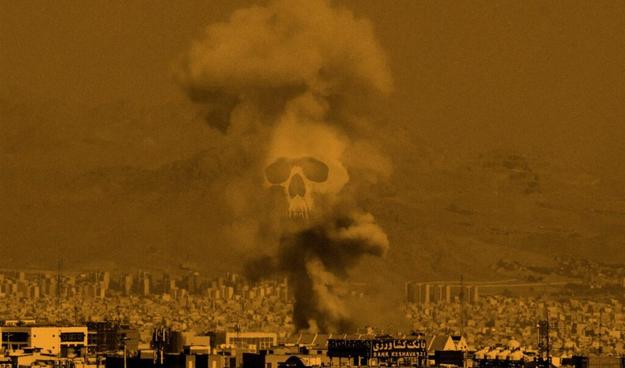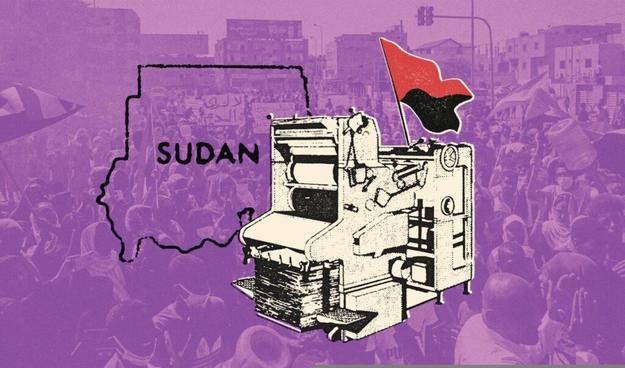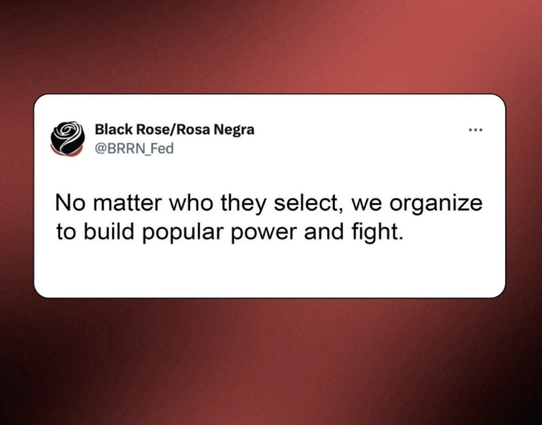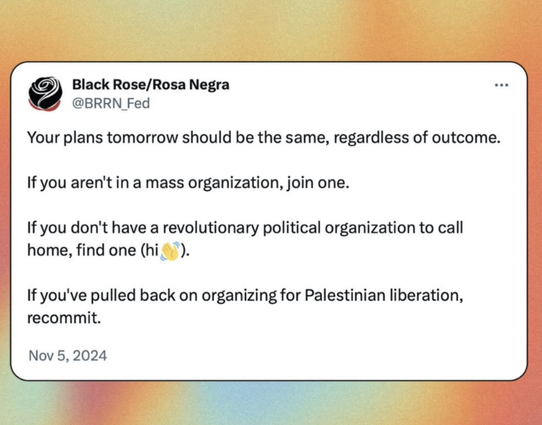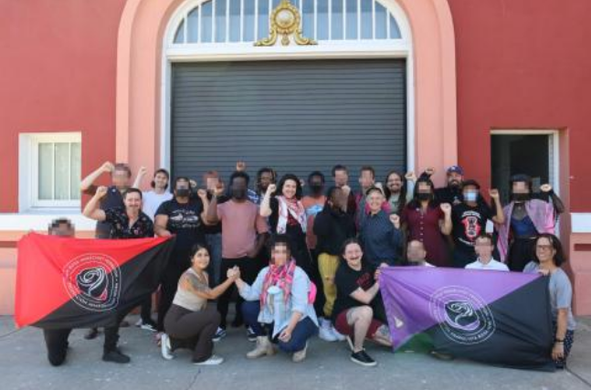What is (Organized) Anarchism? — Black Rose Federation
We present this translation of a booklet produced by our Argentine sibling organization Federación Anarquista Rosario (FAR) as a basic introduction to our tradition within the anarchist movement.
Translation by Enrique Guerrero López
Introduction
For a long time, our organization [FAR] has had the intention of creating an introductory piece on Anarchism, and especially of our current, Especifismo. Mainly because there are different interpretations of Anarchism, fairly widespread, established as a kind of “common sense” that we believe are significantly different from our proposal. Lately Anarchism has been associated with a “rebellious” lifestyle, rather than with a project of struggle and popular organization that aims to achieve a socialist and libertarian society.
This material is introductory, and therefore implies curtailing topics that should be taken up elsewhere, particularly by those who wish to deepen what has been engaged with here.
Our intention is to root this project in the various social sectors that suffer the consequences of Capitalism, seeking to add more comrades to the struggle for a new SOCIALIST AND LIBERTARIAN1 world.
UP WITH THOSE WHO STRUGGLE!
Where Does Our Proposal Come From? (Some History)
Anarchism emerged as a current of socialism at the end of the 19th century in Europe and then, thanks to the phenomenon of immigration, it spread throughout the world. In our country [Argentina], during the last decades of the 19th century and the first decades of the 20th, it was one of the predominant ideologies of the working-class. At that time, exploited workers sought to resist the living conditions imposed on them by the capitalist class, and at the same time they yearned for another social arrangement without exploitation or domination.
The IWA (International Workingmen’s Association) brought together workers and revolutionaries from Europe, and from various countries around the world, to outline a strategy to fight against the system. In that organization, also known as the First International, the figure of Mikhail Bakunin stood out, who argued with Karl Marx on the strategic orientation of revolutionary struggle. The main difference between the two was in relation to the State. Marx argued that the State could be an instrument for the liberation of the working class, while Bakunin proposed that Capitalism and the State were two sides of the same coin. Although this was not the only difference, it was the most important and led to the breakdown of the First International. The field of Socialism would be divided between Marxists and Anarchists.
Anarchism would not go unnoticed in the history of the struggle of the oppressed. It has been the protagonist of great processes of social transformation, such as the Libertarian Makhnovist Ukraine, anarchist contributions to the Mexican Revolution, the Spanish Social Revolution, and the Commune of Manchuria, among others.
What Do We Fight Against? (How We See the System of Domination)
AGAINST CAPITAL
In today’s society, the phenomenon of economic exploitation is so characteristic that it has led some currents of Socialism to think that it is the defining feature of the historical moment in which we live, to the point of thinking that it determines all the rest of the forms of domination. In other words, everything that happens in a capitalist society is explained solely by the economy.
For our part, while we do not believe that exploitation mechanically determines our existence, we do not ignore the importance of this phenomenon, which, in the emergence of our ideology, has been the articulating axis of the organizations and resistance of the oppressed class. What is exploitation? Basically it divides society into classes. Thus we find on the one hand the owners of the means of production and the land, called: Bourgeoisie, Employers, these are the Exploiters. On the other hand there are those who own nothing but their labor power: the Proletariat, the Workers, these are the Exploited.
Through a series of historical processes, capitalist society, since its birth, has created and recreated this structural inequality, also drawing from inequalities inherited from previous historical moments. In this system the Bourgeois “freely hire” the Workers and in exchange for their work they give them a “wage.” This is always less than the wealth generated by the Workers, but enough for their survival. In Capitalism then, the Bourgeois have the freedom to accumulate wealth, and therefore to live in great luxury. Workers, for their part, have the freedom to sell their labor power and thus are barely able to achieve subsistence. This is a conception of freedom, which, as we will see, is absolutely opposite to the one upheld by anarchism.
AGAINST THE STATE
In the current context, defining the State is complex, since throughout history it has changed and perfected itself as an institution of domination.
The State acquired different functions and forms, becoming an increasingly important and constitutive element of the capitalist system.
Schematically, we can say that the State is the institution that suppresses the people’s ability to decide how to administer and carry out social life. The State always works for the operation of the system of domination, intervening in social conflict, guaranteeing the privileges of the powerful and seeking to bring the entire political life of society into its orbit.
If we think about the changes experienced through time, we find that in the 19th century the state had a purely repressive function, but for much of the 20th century it was
becoming a more “friendly” institution for society, guaranteeing certain essential services such as healthcare and education. This adopted form became known as the Welfare State. But the Welfare State did not arise from the goodwill of the rulers, rather it can be explained as a product of a clever maneuver by the dominant classes to contain social struggles, which had generated a significant challenge to Capitalism. It has now been several decades since the State was transformed into what is usually called a Neoliberal State, where its role has focused primarily on ensuring the functioning of the Market.
Despite these changes, the State never abandoned its repressive function, since it holds what is known as the “monopoly on the legitimate use of force,” that is to say, that it has the legal capacity to repress the population to impose its decisions. Nor did it stop trying to control society in various ways, especially in its protection of the exploitative social arrangement which produces wealth and privilege of the Bourgeois.
Today the Neoliberal State primarily assumes the form of domination through social control. This mechanism enables the possibility of highly unequal societies, with highly controlled areas where wealth and power are found, and areas of exclusion, generally located on the peripheries. Excluded populations live in these areas, where the State intervenes in a dual sense: through social containment with welfare policies and through militarization and repression. Over time, social control is assumed by the general population to be normal, incorporating into everyday life the logic of surveillance, allowing the State to transfer this function to society.
It is also important to analyze so-called “democracy” at this point, which, through the fiction of political participation through voting, has the effect of legitimizing the unjust functioning of today’s society. Any possibility of social transformation is subject to the logic of bourgeois democracy, which in practice generates apathy and depoliticization, since the people “delegating” the resolution of their affairs to professional politicians—who centralize this task—lose all connection to and responsibility for social decisions. It must be admitted that these operations aimed at legitimizing the functioning of capitalist society have been relatively successful. Thus, a certain part of the left today is institutionalized, and all its practice is meticulously regulated by the State. From Marxism this orientation is justified by understanding the State as a neutral instrument, which, in the hands of the workers, can serve to achieve Socialism. History shows otherwise, with the experience of the Soviet Union and others that ended up leading to yet another variant of Capitalism.
AGAINST PATRIARCHY
Patriarchal oppression is sustained through asymmetric power relations and uses mechanisms to generate, develop and perpetuate the domination of heterosexual men over women and other gender identities. Over time these differences in power have crystallized in our culture, giving rise to the existence of roles and values assigned to the feminine (for example, weak, caring, sensitive) and the masculine (for example, strong, hard working, intelligent). School, Family, Work, the State and other institutions educate us to assume these roles, while those who do not fit into them are discriminated against in different areas of life. Likewise, everything related to the feminine is undervalued, and that translates into a lack of access to rights and participation.
We can say that Femicides are the most visible expression of patriarchal violence, however there are other violent mechanisms that are unleashed on women’s bodies, which have important effects on the reproduction of the system of domination. Problems such as Sex Trafficking, the Violation of Sexual and Reproductive Rights — that is, the elimination of bodily autonomy — high levels of Sexual Harassment both within the family and public, and Wage Discrimination are just some of the many expressions of Patriarchy. While it is more evident in the cultural sphere, Patriarchy operates in an economic dimension, since, within the gender roles imposed by this form of oppression, women in general attend to domestic tasks (eg, feeding, cleaning, caring for children and the elderly) but without any remuneration or recognition. This is very relevant because social reproduction is key to the functioning of the system. Even in Capitalism this unpaid work is essential for the functioning of the market, since it allows people to arrive well fed, rested, and prepared to be exploited.
Now, in a Capitalist System where everything is measured in money, it is thanks to Patriarchy that domestic work is understood as an uncompensated obligation, since this mechanism of oppression appeals to the moral imposition that falls on women to assume these tasks for the mere fact of being women.
AGAINST COLONIALISM, IMPERIALISM AND RACISM
Throughout history, Capitalism expanded, creating institutions and social forms that did not exist before. Borders and Nation-States emerged from this process. The notion that political authority must perfectly coincide with a clearly determined geographic space and borders is an invention of Capitalism; this notion did not exist before.
The idea that the spaces occupied by a State must coincide with a Nation, that is, with a group of inhabitants with a common culture and identity, is also new.
As we know, the region in which we live is going through a colonization process that began in the 15th century, with the arrival of conquerors from Europe. This meant the possibility of expanding Capitalism, through the looting of common goods and also the standardization of the world, imposing on the peoples of these lands the culture, laws and language of the conqueror. The ideology of Nationalism is part of this process, which occurred through systematic violence and genocide against indigenous and black populations.
From this process, Racism was established as a mechanism of cultural and political domination, dividing society into castes, where races considered inferior occupied the lowest echelons. We can assert that this form of Racism endures to this day.
The initial phenomenon of Colonization began to transform itself and its economic and cultural dimension took on a greater intensity through what is known as Globalization. In this way, a world with central countries was configured, where most of the technologically advanced industrial production is found, and peripheral countries from which natural resources are extracted at the expense of peoples and nature.
In today’s world there are various Imperialist World Powers that compete for the territories and markets of the world. This cuts through the reality of the peoples on a daily basis, since these imperial projects intervene not only through the military dimension but, as we said above, their presence is important economically, politically and culturally.
Some expressions of this form of oppression can be found in: the presence of foreign military bases in different parts of the country and region, in the looting of common goods and economic dependence, in the colonization of culture, in the interference of the transnational control and surveillance apparatuses, in the action of international NGOs that impose welfare. In turn, the local State itself operates with a colonialist logic, repressing and starving native populations, denying them their right to self-determination.
What Do We Propose? Toward a Socialist and Libertarian Society
We aim, as final objectives, at the destruction of the Capitalist System of Domination and the construction of a Socialist and Libertarian Society.
The destruction of the system of domination can be framed in the pursuit of a revolutionary process of rupture with the current social order, which occurs in parallel with the construction of the society we want.
A break with domination as a model of power, and the construction of a model of Popular Power, necessarily leads us to discard statist and institutional routes in our strategy since these are contradictory with the objective of social revolution.
That is why we advocate Self-Management, Libertarian Federalism, Anarcho-Feminism and Anti-Colonialism as methodologies of social organization, which can transform the power model of domination and turn it into one of Popular Power.
We propose, therefore, a federal organization of society, organized from the bottom up through basic bodies of discussion and decision making, which are coordinated with each other through delegation, forming a dynamic, decentralized and directly controlled society. The objective of Federalism is a new institutionality, where there is no place for any kind of privilege, be it economic, social or political. It is an institutional framework where the revocation of delegates is immediately assured and where, therefore, there is no room for the usual political irresponsibility that characterizes Representative Democracy.
This is a practice and an institutionality that must reflect the rights and obligations of all members of society. Their right to be elected and elector, and also their obligation to report back in an effective, practical, daily way. This must be applicable both for the broadest global bodies as well as for bodies at the grassroots.
In the economic sphere, this process will go hand in hand with the abolition of private property and socialization of all the means of production, all that is produced and all the resources vital to humanity. Building a new egalitarian society carries with it a distribution of the collective product of our labor based on the determination of needs and the distribution of work equitably according to individual capacities. Guiding all economic activity towards the sustainability of life, understanding that the economy also includes all actions related to the reproduction and care of people and that this must also be carried out within a framework of respect and protection of the natural world of which we are part.
In the political-cultural sphere, the destruction of Patriarchy and Racism in pursuit of a just society—which does not discriminate based on people’s gender or race—will not only imply questioning of our existing social relationships, but also require the construction of other types of relationships, alongside the specific struggles of social movements.
But we understand these organizational models in relation to the processes of struggle, and with the particularities of each place, taking into account cultural integrity, language, ways of life, and ethnic identities. Thus, we do not think of a revolution as a homogenizing phenomenon of society, but rather, as one precisely capable of making those individual, collective, cultural, regional, etc. particularities blossom, so that they do not deny others and so that they recognize and strengthen each other in these differences. That is why we advocate anti-colonialism as a perspective and methodology of action that aims at people’s cultural self-management.
How Can We Achieve Our Objectives?
Especifismo proposes organizational action through two parallel paths: the path of Anarchist Political Organization and the path of Social Organization for the class struggle.2 We chose this organizational method because it respects the specificity and dynamics of each space of struggle, making social spaces remain open to comrades of different ideologies, in addition to the fact that the political organization can function cohesively without being tied to the dynamics of social struggles.
The anarchist political organization practices Federalism and is therefore deeply democratic, with decisions being made from the base. Collective Responsibility and Discipline are also emphasized, that is, carrying out agreements, consistency and constancy in the daily life of militants. The organization functions based on collective agreements for which Theoretical, Ideological and Strategic Unity is fundamental. At the same time, it carries out Social Insertion in spaces where the class struggle takes place to become a motor of these struggles.
To carry out social insertion, which implies organization at the social-political level, the organization is divided into fronts: Union, Neighborhood, Student, etc. It is on this terrain where the struggle against the system of domination takes place, resisting the oppression of Capital, the State, Patriarchy, and Imperialism. This is where a project of Revolutionary Rupture with the system is built.
This project is built from the perspective of Popular Power, which implies that social struggles are carried out with a combative method of construction from the base, with the leadership of popular organizations. Class Independence is extremely important in this sense, in order to maintain autonomy from the State and Capitalism. For this reason, the method of struggle that we propose for the popular field is that of Direct Action, which forges a Strong People in the daily struggle and resistance.3
It will be the task of the political organization to promote mobilization for short-term demands within the social milieu, articulated with the project of radical transformation of society, with a view toward building a Socialist and Libertarian society.
For Socialism and Freedom
Organized Anarchism or Especifismo is a conception of Anarchism that emerged in Latin America in the 1960s from the impetus of the FAU (Uruguayan Anarchist Federation). Especifismo is a historical form of organization that is related to a broader tradition of Anarchism called Organizational Dualism, which proposes anarchist organization at two levels: an ideological-political one, specifically anarchist, composed of the Political Organization and another a social-political level composed of Social or Mass Organizations. We have already seen this proposal in the conceptions and practices of Bakunin and Malatesta.4
We aim at a change in the social structures that sustain Capitalism by deploying a method of building Popular Power which is developed in the daily class struggle. For this purpose, in addition to organizing ourselves politically as anarchists in the FAR, we play an active part, strategically and collectively, in Unions, Neighborhood and Student Organizations, etc.
“…high politics is not the origin point (…) or reason behind our struggle. The origin is in the pain and longing of that great humanity of which our people are a part.
Because we know that man [sic] is a social being, we want him [sic] to develop his [sic] capacity and put it at the service of society, because we want all decisions that concern society to be assumed and resolved in a social way, because we want wealth not to be individual or of a few but social, of all, that is why we call ourselves Socialists.
Because we trust more in agreement than in imposition, in knowledge than in coercion, in freedom than in authority. That is why we are libertarians.
But we’ve already learned that labels are sometimes misleading. That is why we do not dedicate ourselves to labeling the struggle of the oppressed. There may be people who identify themselves in a similar way who do not know well what they want, and there are also those with other names, or sometimes even without knowing how to give it a name, seeking the same thing.
We call all those who, without pettiness, in their own way and in their measure, fight for these ideals.”
Gerardo Gatti
Definitions of a Comrade
Buenos Aires, June / July 1975
The contents expressed in this booklet are not intellectual speculations carried out in spaces far removed from popular reality, rather they are systematizations of years of struggle and organization, which function as working hypotheses and point to an accumulation of experiences toward the construction of a revolutionary strategy in the anarchist sense. Therefore, its reading, and its necessary rereading throughout the militant trajectory of each reader, implies a commitment to the cause of SOCIALISM AND LIBERTY.
Notes
- Libertarian here refers to a socialist political perspective that embraces federalism and opposes the state. Originally used by the French anarchist communist Joseph Déjacque in 1857 as a synonym for anarchism, the term only recently became associated with a strain of far-right pro-market individualism. This inversion of the term’s original meaning is largely limited to the United States; elsewhere in the world the phrase retains its association with left-wing anti-state socialism. ↩︎
- We took the concept of “parallel paths” from a Catalan anarchist, Antonio Pellicer Paraire, who belonged to the Bakuninist wing of the 1st International, and who was very influential in the formation of anarchism and in the organized labor movement in Argentina. ↩︎
- See: Create a Strong People: Discussions on Popular Power by Felipe Corrêa. ↩︎
- See: Bakunin, Malatesta and the Platform Debate: The Question of Anarchist Political Organization by Felipe Corrêa and Rafael Viana da Silva. ↩︎
source: Black Rose Federation
https://abolitionmedia.noblogs.org/?p=18766
#anarchism #blackRoseFederation #especifismo #platformism
